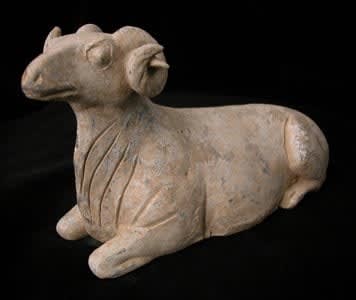Tang Terracotta Sculpture of a Recumbent Ram, 618 CE - 906 CE
Terracotta
5
H.912
Further images
During the Tang Dynasty, sculptural effigies of domesticated animals were often interred in the tombs of nobility and elite members of the social hierarchy. Created in all media, these sculptures...
During the Tang Dynasty, sculptural effigies of domesticated animals were often interred in the tombs of nobility and elite members of the social hierarchy. Created in all media, these sculptures accompanied the spirit of the deceased into the afterlife. While similar examples exist, most were found harnessed to wagons and carts and were meant to function as beasts of burden. However, this sculpture was discovered buried as part of a herd, contained inside a sculpted miniature pen with other domesticated animals, suggesting that this ram served as nourishment. In China, the ram is one of the Twelve Terrestrial Branches of the Chinese calendar and is the emblem of retired life. A recumbent ram or sheep symbolizes the Confucian virtue of filial piety. During the Tang Dynasty, the Chinese believed that the afterlife was a continuation of our earthly existence. Thus, logically, as we require food to nourish our bodies on earth, so too will we require food to nourish our souls in the afterlife. It is possible this sculpture was created to serve as food for the afterlife. However, much more than a mere sculpture; this ram is a gorgeous memorial to the religious and philosophical beliefs of the Tang Dynasty.









